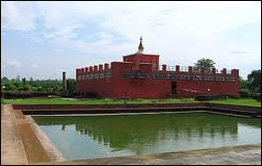|
BUDDHIST DESTINATION |
|
|
|
|
|
|
|
|
|
|
|
|
|
|
|
|
|
BUDDHIST SITES |
|
|
|
|
|
|
|
|
| LUMBINI |
|
|
| The birthplace of the Gautama Buddha, Lumbini, is greatly revered by every Buddhist, being one of the four holy places of Buddhism, namely the sites of his birth, enlightenment, first discourse, and death. Situated in the foothills of the Himalayas in modern Nepal, Lumbini in Buddha's time, was a beautiful garden full of green and shady sal trees (Shorea). King Suddhodana, father of Gautama Buddha was of the Shakya dynasty belonging to the Kshatriya or the warrior caste. Maya Devi, his mother, gave birth to the child on her way to her parent's home in Devadaha while taking rest in Lumbini under a sal tree in the month of May in the year 563 B.C. It is said that Maya Devi was spellbound by the natural beauty of Lumbini and while she was standing, she felt labor pains and catching hold of a drooping branch of a Sal tree, the baby, the future Buddha, was born. A stone marks the exact spot, where Lord Buddha was born. |
 |
| On the south of the Maya Devi temple there is the famous sacred bathing pool known as Puskarni. It is believed that Maya Devi took a bath in this pool before the delivery. A visit to Lumbini, the birth-place of Buddha, is not only for spiritual enlightenment but also for solace and satisfaction that one gets in such a calm and peaceful place. |
| Lumbini Attractions |
The place itself is interesting as a whole, the landscapes and the green forestry. However Maya Devi temple and the Stupas and the Pillar built by Ashoka are really worth a visit. Recently, several beautiful shrines have been constructed by devotees from all over the world. A visit to Lumbini is not only for spiritual enlightenment but also for solace and satisfaction that one gets in such a calm and peaceful place.
Maya Devi Temple
Lumbini remained neglected for centuries. In 1895, Feuhrer, a famous German archaeologist, discovered the great pillar,further exploration and excavation of the surrounding area revealed the existence of a brick temple and a sandstone sculpture within the temple itself which represents the scenes of Buddha�s birth. On the south of the Maya Devi temple there is the famous sacred bathing pool known as Puskarni. It is believed that Maha Devi took a bath in this pool before the delivery. The temple is built gradually and is composed of many temples, one after the other. It is also found that there is possibility that a Ashoka Stupa existed in the place of temple.
Ask For Lumbini Travel Detail
The Ashokan pillar
The Ashokan Pillar, essentially erected by Ashoka (249 BC) visited Lumbini and erected an inscribed Ashokan Pillar on the spot of Buddha's birth. The inscription of the pillar (the oldest in Nepal) declares that Ashoka granted Lumbini tax-free status in honor of Buddha�s birth. It is 6m high and half of it is beneath the ground. It is behind the Maya Devi Temple, to the west of the temple. Emperor Ashoka erected many other pillars throughout India. The carved top of the pillar has never been found.
The Buddhist monastery
Its built in the way of the modern Buddhist temples of Nepal but is quite important in the purview of architecture of the walls. The middle hall contains some exquisite murals resembling the medieval periods'. |
| How to reach |
Air - Bhairahwa is the nearest airport, 22 kms , well connected to Kathmandu airport. At present, about 22 international airlines connect Nepal to various other destinations in Asia and the Middle East.
Rail - Gorakhpur, In India, is the nearest railhead, 122 km from Lumbini.
Road - Good motorable roads connect Bhairahwa to Lumbini, and also other important cities of Nepal. India border is 22 kms.
|
|